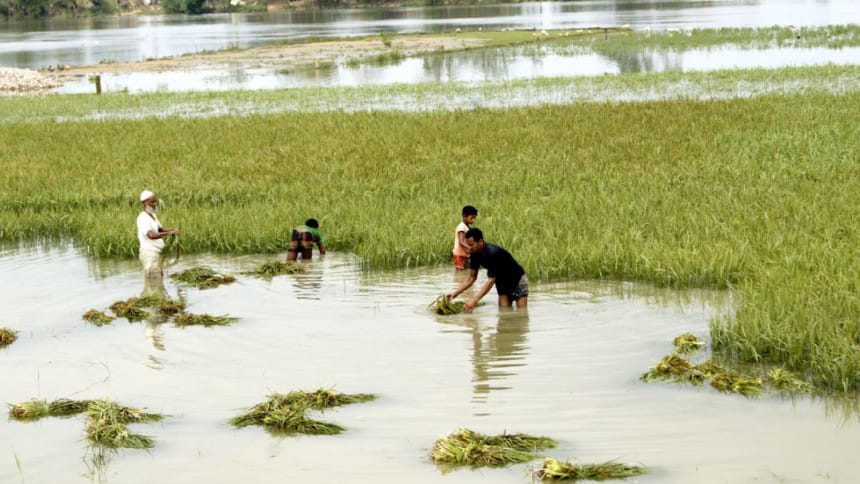Empowering the haor people

Human beings, by nature, are surprisingly resilient. We fight back against natural disasters, human-induced hazards, economic vulnerabilities, and health shocks and, in the process, we keep learning how to cope with and adapt to these adversities.
But the degree to which one can withstand such adversities varies from person to person, even from community to community, based on their capacity and resources. We use the term "resilience" to refer to such capacity of a system (individual, group, and community) to "bounce back" after coming across hardships.
Today, resilience is widely used from different perspectives both in academic and development discourses. Accordingly, building resilience of people to natural, environmental and other socio-economic hazards has become a key development agenda over the last couple of decades. The United Nations (UN) in its Sustainable Development Goals (SDGs) incorporated the issue of resilience emphasising on "building the resilience of the poor and those in vulnerable situations and reduce their exposure and vulnerability to climate-related extreme events and other economic, social and environmental shocks and disasters." Moreover, Bangladesh's 7th Five Year Plan (7FYP) adopted complementary strategies of building resilience of people to climate-related hazards and natural disasters in addition to strategies for economic growth of 7.4 percent.
However, Bangladesh is reportedly at greater risk of natural disasters because of global warming and climate change taking place. The northeastern haor region of the country is, among other regions, at the receiving end of the adverse impact of that change. The overriding challenge of haor inhabitants is perhaps the fact that they have limited livelihood options if their existing livelihoods are disrupted by natural calamities. The complexity of this challenge restricts their livelihood options—holding them back from joining the journey towards national progress.
The haor dwellers mainly rely on Boro crops and fishing, while a minority section depends on livestock rearing and small business. Hence, enhancing resilient livelihood of haor dwellers—a livelihood that can sustain its key functions (food, income, poverty reduction, etc.) and absorb the impacts of disasters and shocks without causing major disruption in the day-to-day functions —is their utmost need, in line with the priority of SDGs and 7FYP of Bangladesh.
Four possible interventions can be chalked up to enhance the livelihood resilience of haor dwellers. Firstly, we need to ensure security of the crops cultivated in the area. Early flash flood is a matter of prime concern for these geographically vulnerable areas, disrupting livelihoods every 2-3 years. Flash floods damage the Boro crop which is the only means of livelihood for most of them.
A number of factors are associated with this. Flash floods take place mainly because of depression-like landform and rainfall runoff from across the border of India. The governance issues pertinent to the construction and repair of the embankment compound this geographical challenge. Last year, the government came up with a solution: the Kabita (money for work) Policy 2017, laying out the details of activities of the embankment projects which are time-bound for the associated committees.
But even after the policy was put into effect, the formation of the committees and starting of the projects have reportedly been delayed. With a view to ensuring their crop security, strong implementation of the policy is certainly required. Popularising existing short-duration crop variety in the areas, climate-smart vegetable cultivation, bringing kanda—a slightly higher land typically government-owned and unused—into cultivation, and enhancing agricultural research are also needed to ensure resilient livelihoods for the population.
Secondly, when it comes to livelihood resilience, it is necessary to create linkages between wider markets and the haor region which is restricted by geographical isolation, and fragile and inadequate road networks. According to the Master Plan of Haor Area, 11 of the haor upazilas are not yet connected with road networks. During flash floods and regular inundation, boats are the only means of transport; the situation gets worse when afal—a type of high wave—takes place during monsoon flooding. The road networks and other communication means need to be improved taking the ecological aspect of the area into account. With the leading role of the Department of Agricultural Extension (DAE), commercial livestock rearing needs to be facilitated, especially sheep farming which has high adaptive capacity to the ecology of the region. These people will be keen to start commercial livestock rearing once access to the wider market becomes easier.
Thirdly, the government should encourage private sector investment and small-scale entrepreneurship in these areas. The key may be to provide the right incentives/leverage, e.g. tax exemption, special investment loan, and legal protection for those willing to invest in the area. The commercial sector will gain momentum if communication infrastructure is developed and skilled human resources are made available. Following BRAC's model of skills development, establishment of vocational institutes and linking the trainees to the employers may be an effective approach for the government and other organisations. In addition to government efforts, NGOs should also come forward with some skills development programmes.
And finally, all of our development agenda should reflect the special needs of the hard-to-reach region. Special allocation for the region in our budget is also essential. On the government's part, the master plan should be implemented with high priority. We expect wider reflection of the master plan in the next FYP. Furthermore, given the socio-economic backwardness and vulnerable ecological set-up, the next FYP should include the haor region in its lists of "lagging regions" and "disaster-prone regions."
While recurrent natural disasters continue to hold the population living in the haor basin back, resilient livelihood may pave a sustainable way forward in the face of such disasters. If our development agenda remains too focused on national growth rate, the lagging regions will stay left behind—with even greater spatial disparity. Unless we are able to create a resilient haor community, achieving the SDGs—the thrust of which is "leaving no one behind"—will remain an unfulfilled aspiration.
Shekh Farid is Social Investigator for the Advocacy for Social Change Programme at BRAC. Email: [email protected]

 For all latest news, follow The Daily Star's Google News channel.
For all latest news, follow The Daily Star's Google News channel. 



Comments